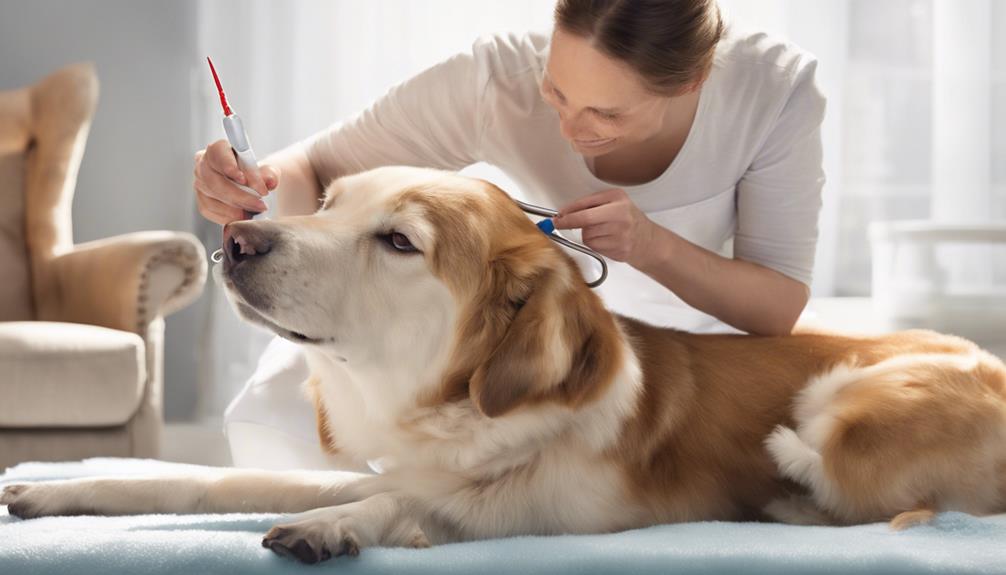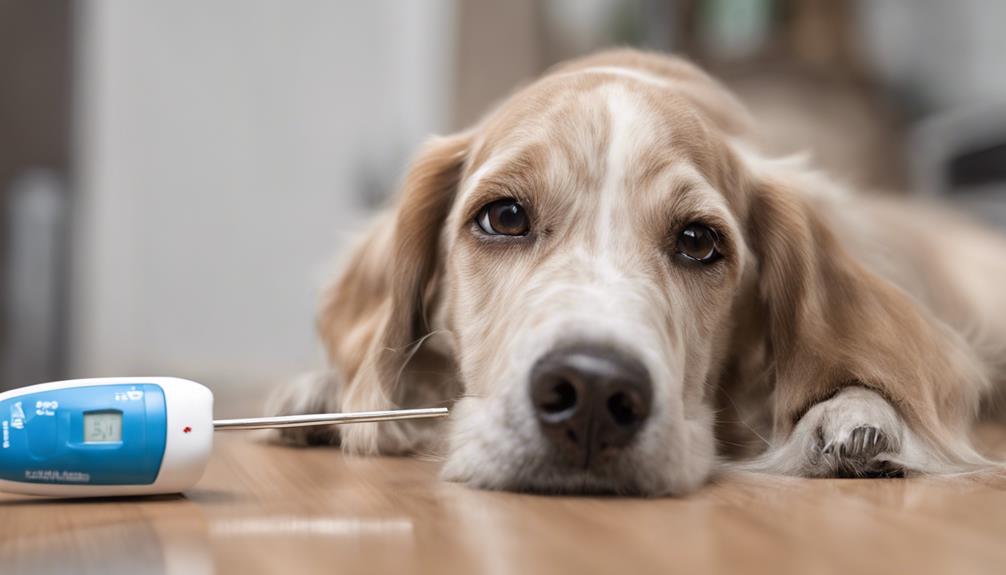To check a dog's temperature safely, select the right thermometer such as an ear or rectal one for accuracy. Gather supplies like a digital thermometer and lubricant. Make sure your dog is comfortable in a quiet space. Insert the rectal thermometer carefully with lubrication. Hold it steady for 1-2 minutes. Securely fasten the thermometer in place to prevent slipping. Record the temperature promptly and consult a vet if needed. Remember a normal range is 100-102.5°F. Seek professional advice for temperatures above 104°F. Following these steps guarantees a safe process and accurate assessment of your dog's health.
Key Takeaways
- Use a lubricated, veterinary-labeled rectal thermometer.
- Securely hold thermometer steady for 1-2 minutes.
- Record temperature promptly and consult a vet.
- Monitor dog's reaction for discomfort during insertion.
- Maintain a log of temperature readings for trends.
Choosing the Right Thermometer
When selecting a thermometer for your dog, opt for either an ear or rectal thermometer to guarantee accurate and safe temperature readings.
Ear thermometers are convenient and quick to use, making them ideal for dogs who may not tolerate having a thermometer inserted rectally. They provide a reliable temperature reading in just a few seconds.
On the other hand, rectal thermometers are considered the most accurate way to measure a dog's temperature. While it may require a bit more time and patience, inserting the rectal thermometer properly ensures a precise reading, critical for monitoring your dog's health.
Both options are safe when used correctly, but it's vital to choose the method that best suits your dog's temperament and comfort level.
Prepare Necessary Supplies

To guarantee a successful temperature reading for your dog, gather essential supplies such as a digital thermometer, water-based lubricant, and pet restraint tools. A digital thermometer is preferred for its accuracy and ease of use. Make sure the thermometer is labeled exclusively for veterinary use to avoid any chance of cross-contamination.
The water-based lubricant will make the process more comfortable for your dog and help with the insertion of the thermometer for a rectal temperature reading. Additionally, having pet restraint tools on hand will assist in keeping your dog still during the procedure, ensuring safety for both you and your furry friend.
Prepare a designated area with good lighting to accurately measure the temperature. Having towels or blankets nearby can provide comfort and support for your dog during the process. Keeping treats or rewards handy can also help keep your dog calm and cooperative throughout the temperature-taking process.
Ensure Your Dog Is Comfortable

Guaranteeing our furry companions feel at ease is paramount during the temperature-taking process. To start, choose a quiet and comfortable location for the temperature check. This helps reduce stress on your dog, making the experience more pleasant.
Use gentle restraint to keep your dog still, such as softly holding their ear or gently securing them in place. Speaking in soothing tones can reassure your dog and help keep them calm. Offering treats or positive reinforcement creates a positive association with temperature checks.
Take your time and avoid rushing the process to ensure your dog feels comfortable throughout. If needed, use proper restraint to prevent excessive movement during the measurement. Remember, a calm and relaxed dog will make it easier to get an accurate reading of their normal body temperature.
Insert the Rectal Thermometer

When inserting the rectal thermometer, remember to only push it 1-2 inches into the dog's rectum for an accurate reading.
Lubricate the thermometer with petroleum jelly or baby oil to make the process smoother.
Hold the thermometer steady for 1-2 minutes to guarantee a stable temperature reading.
Inserting the Thermometer Properly
How deep should we insert the rectal thermometer to guarantee an accurate temperature reading for our dog?
To make sure an accurate reading, insert the rectal thermometer approximately 1-2 inches into your dog's rectum. It's essential to gently and securely place the thermometer against the rectal wall for the most precise measurement. Holding the thermometer in place for 1-2 minutes allows for an appropriate temperature reading.
To aid in smooth insertion and provide comfort for your dog, consider lubricating the thermometer tip with petroleum jelly or baby oil. Proper insertion depth is key in obtaining an accurate temperature reading, so take care to insert the thermometer correctly to make sure the most reliable results for your pet's health assessment.
Ensuring Comfort and Safety
How can we guarantee the comfort and safety of our dog when inserting the rectal thermometer?
- Prepare the rectal thermometer with a water-based lubricant to facilitate insertion.
- Gently insert the thermometer to the specified depth in the rectum.
- Make sure your dog is lying down for a more comfortable and accurate temperature reading.
- Remember to label the thermometer exclusively for animal use to prevent cross-contamination.
Monitoring Temperature Accurately
For a vital temperature reading, carefully insert the rectal thermometer 1-2 inches into the dog's rectum for 1-2 minutes. This guarantees accurate temperature readings. Remember to lubricate the thermometer tip with petroleum jelly or baby oil for easier insertion.
Rectal thermometers provide the most dependable and precise temperature measurements in dogs. While monitoring the process, pay attention to the dog's reaction for any signs of discomfort. Proper insertion depth and duration are essential for obtaining an accurate reading.
Hold the Thermometer in Place

To guarantee an accurate temperature reading, delicately hold the thermometer in place to prevent it from slipping out during the measurement. When handling this critical step, remember the following:
- Ensure it's securely inserted: Proper insertion guarantees an accurate reading.
- Gently hold the thermometer: Preventing it from slipping out is essential for precise results.
- Avoid sudden movements: Any sudden shifts could disrupt the thermometer's position.
- Keep the thermometer steady: A steady hand ensures consistent contact with the rectal wall.
Record the Temperature Reading

When taking your dog's temperature, it's essential to record the reading promptly. This allows us to monitor any changes and identify abnormalities.
Interpret the Reading
Upon recording the temperature reading immediately after taking it, we noted it as 101 degrees Fahrenheit. When interpreting the reading, it's vital to understand the importance of the temperature for your dog's health. Here are some key points to keep in mind:
- Consult with Your Vet: Share the temperature reading with your veterinarian to seek their professional evaluation.
- Keep a Log: Maintain a record of temperature readings to track any changes over time.
- Monitor Trends: Analyze the data to identify any patterns or abnormalities in your dog's temperature.
- Ensure Health Evaluation: Regularly checking your dog's temperature helps in assessing their overall health status.
Note Any Abnormalities
After recording the temperature reading of 101 degrees Fahrenheit, it's crucial to note any abnormalities such as elevated or low temperatures that may indicate potential health issues in your dog.
Monitoring your dog's temperature regularly can help you detect any abnormalities early on. If you observe consistently high or low temperatures, it's vital to seek veterinary attention promptly.
Keeping a log of temperature readings allows you to track any fluctuations over time. Any significant changes in temperature readings should be documented and shared with your veterinarian for further evaluation.
Monitor Trends Over Time
To track trends over time, we consistently record the temperature reading each time we take our dog's temperature. By documenting temperature variations, we can monitor changes in health and identify any abnormalities early on. Keeping a log of temperature readings allows us to track trends and provide valuable information to our veterinarian during check-ups.
This consistent temperature recording not only helps in evaluating our dog's overall well-being but also aids in detecting underlying health issues promptly. Remember, staying vigilant and documenting temperature trends can play an important role in keeping our furry friends healthy and happy.
Monitor Normal Temperature Range

Monitoring the typical temperature range of a dog is essential for evaluating their health status accurately. A dog's normal temperature falls between 100-102.5°F, with any deviation indicating an underlying issue. Fever in dogs is often a sign of infection, prompting the immune system to respond. Abnormal temperatures, whether too high or too low, can harm the body and should be addressed promptly. By understanding the normal dog temperature range, pet owners can better gauge their dog's well-being and seek appropriate care when needed. To help visualize this range, refer to the table below:
| Temperature Range (°F) | Description |
|---|---|
| Below 100°F | Below Normal |
| 100-102.5°F | Normal Range |
| 102.6-104°F | Mild Fever |
| 104.1-106°F | Moderate Fever |
| Above 106°F | High Fever |
Attend a Pet First Aid Course

When it comes to caring for our furry friends, attending a pet first aid course is vital. By learning essential pet skills, gaining first aid knowledge, and enhancing emergency preparedness, we can be better equipped to handle any unforeseen situations.
These courses cover important topics like CPR, wound care, and temperature monitoring, providing us with the tools needed to respond effectively in times of need.
Learn Essential Pet Skills
Have you considered attending a pet first aid course to learn essential skills for handling emergencies with your furry companion? Attending such a course can equip you with the knowledge needed to confidently handle health emergencies your pet may face.
Here are some benefits of attending a pet first aid course:
- Learn how to gently monitor your pet's temperature.
- Gain knowledge on pet first aid techniques, including CPR and wound care.
- Understand the normal temperature ranges and critical signs for your pet.
- Be prepared to handle various health emergencies effectively.
Gain First Aid Knowledge
Considering attending a pet first aid course to equip yourself with essential skills for handling emergencies with your furry companion can be a proactive step towards ensuring your pet's well-being.
Attending such a course provides valuable knowledge on taking a dog's temperature safely, a critical aspect of first aid. You'll learn how to recognize signs of distress and when to seek veterinary assistance promptly.
Understanding the significance of quick and appropriate action during pet health emergencies is key. Acquiring these skills will enable you to effectively care for your pet in critical situations before professional help arrives.
Enhance Emergency Preparedness
Attending a pet first aid course greatly enhances our preparedness for handling a variety of pet health emergencies effectively. These courses provide essential knowledge on how to respond to emergencies and administer basic first aid to pets. Learning pet first aid can help pet owners act quickly and effectively in critical situations, potentially saving their pet's life.
Pet first aid courses cover topics like CPR, wound care, choking, and recognizing signs of distress or illness in pets.
- Gain crucial skills in administering first aid to pets
- Learn how to respond promptly to pet health emergencies
- Enhance confidence in handling critical situations
- Acquire knowledge to potentially save your pet's life
Seek Veterinary Advice When Needed

Seeking veterinary advice promptly is essential when your dog's temperature deviates above 104°F or below 99°F. Consulting with a vet guarantees accurate interpretation of temperature readings and appropriate treatment for any temperature-related concerns. It is vital for dog parents to reach out to veterinary professionals for guidance on abnormal temperature readings.
Here is a helpful table to understand when to seek veterinary advice regarding your dog's temperature:
| Temperature Range | Action Needed |
|---|---|
| Above 104°F | Contact your vet immediately. |
| Below 99°F | Seek veterinary advice promptly. |
Important Reminders for Temperature Monitoring

To guarantee precise temperature monitoring for your dog, it's essential to use a correctly labeled thermometer and record temperatures accurately. When monitoring your dog's body temperature, here are some important reminders to keep in mind:
- Normal Range: A dog's normal temperature typically falls between 99.5–102.5 °F (37.5–39.2 °C).
- Digital Thermometer: Make sure you use a digital thermometer specifically designed for rectal temperature readings for accurate results.
- Veterinary Attention: If your dog's temperature rises above 104 °F (40 °C), seek immediate veterinary attention.
- Regular Checks: Monitoring your dog's temperature regularly can help establish a baseline for their health and aid in early illness detection.
Frequently Asked Questions
How Do You Take a Dog's Temperature?
Taking a dog's temperature involves using a digital rectal thermometer, lubricating it, gently inserting it into the rectum, and holding it against the rectal wall for 1-2 minutes.
Normal dog temperature ranges from 99.5–102.5 °F (37.5–39.2 °C). If the temperature exceeds 104 °F (40 °C), seek immediate veterinary attention.
This method guarantees an accurate reading and helps monitor your dog's health effectively.
Can I Take My Dogs Temperature With a Touchless Thermometer?
Touchless thermometers aren't advised for taking a dog's temperature due to their potential inaccuracies. The distinctive shape of dog ear canals and the lack of contact with the body surface may lead to inconsistent readings.
To guarantee precise temperature assessment, it's best to avoid touchless thermometers and opt for rectal thermometers, which provide more reliable results.
Monitoring your dog's health through proper temperature measurement is vital for their well-being.
How Can I Check My Dog's Temperature Without a Thermometer?
Without a thermometer, checking your dog's temperature can be done by observing signs like lethargy or shivering. Feeling their ears, paws, or nose for warmth can also give you an idea.
Pay attention to hydration levels, appetite, and energy too. Look for redness in eyes or gums, coughing, and changes in food intake.
When in doubt, seek prompt vet advice for proper evaluation and treatment.
Can You Take a Dog's Temperature With an Ear Thermometer?
Yes, you can take a dog's temperature with an ear thermometer. It's designed specifically for measuring temperature in the ear canal.
To do so accurately, gently insert the thermometer tip into the dog's ear canal. This method is less invasive and provides a quick reading. Proper positioning of the thermometer is essential for precise measurements.
Ear thermometers are suitable for home use and can be convenient for monitoring your dog's temperature.
Conclusion
In summary, taking your dog's temperature is a vital skill for pet owners to have. Remember, just like with people, a dog's temperature can be an important indicator of their health.
So, make sure to choose the right thermometer, prepare your supplies, and follow the steps carefully to guarantee a safe and accurate reading.
By monitoring your dog's temperature regularly, you can help keep them happy and healthy. Remember, a healthy dog is a happy dog!










